Ask the Developer Vol. 3, Big Brain Academy: Brain vs. Brain
2 December 2021
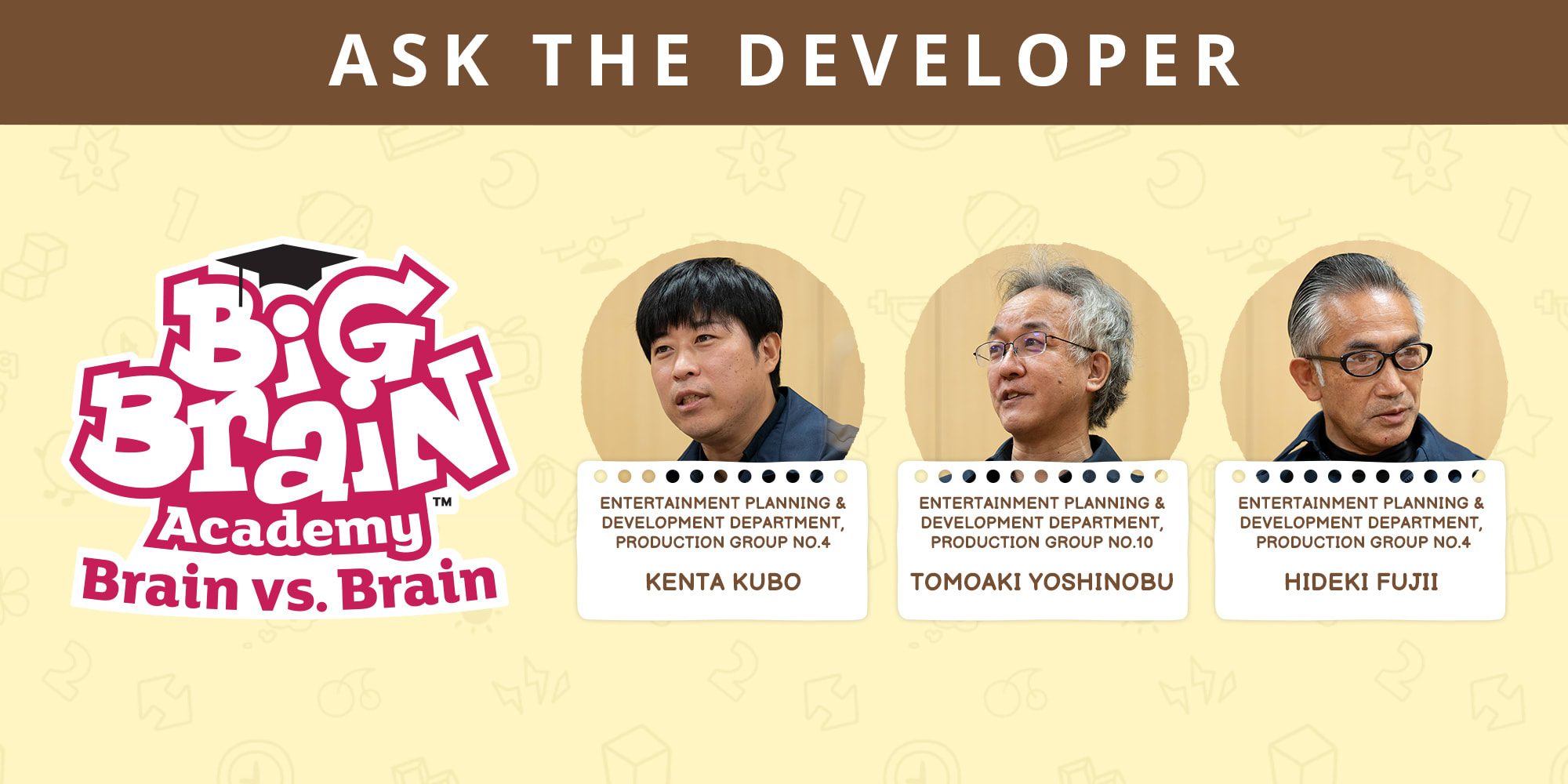
The brains behind the Big Brain Academy series share their development insights and thoughts on the upcoming Nintendo Switch version.
In this third volume of Ask the Developer, an interview series in which Nintendo developers convey in their own words Nintendo’s thoughts about creating products and the specific points they are particular about, we're talking to the three developers behind the Big Brain Academy series, including the upcoming game Big Brain Academy: Brain vs. Brain for Nintendo Switch, launching on December 3rd.
Chapter 1: Parents and children split apart
First, could I ask you to briefly introduce yourselves?
Kenta Kubo (referred to as Kubo from this point on):
I'm Kubo. I am the director for the Nintendo Switch game we are releasing now, which is called Big Brain Academy: Brain vs. Brain.
Tomoaki Yoshinobu (referred to as Yoshinobu from this point on):
I'm Yoshinobu. I was the director of Big Brain Academy for Nintendo DS(1) and Big Brain Academy for Wii(2). I was also the main programmer for the Nintendo DS version.
(1)Released in Europe on Nintendo DS in July 2006. This game let players enjoy a collection of minigames across five genres based on the theme "brain-bending activities".
(2)Released in Europe on Wii in July 2007. This game let players enjoy a collection of minigames across five genres together with other people.
Hideki Fujii (referred to as Fujii from this point on):
I'm Fujii. I was also the planner and designer for the Nintendo DS and Wii versions of Big Brain Academy.
Thank you very much. In addition to Kubo-san, who is a developer for the new Nintendo Switch game, we've also invited Yoshinobu-san and Fujii-san. They weren't involved with the development of the Nintendo Switch version, but they were developers for the Nintendo DS and Wii versions. This way, we can hear about all the games in the Big Brain Academy series as a whole.
First, Kubo-san, could you explain Big Brain Academy: Brain vs. Brain for Nintendo Switch a little bit?
Kubo:
Of course. Big Brain Academy: Brain vs. Brain is a minigame collection with activities for your brain covering five different genres: Identify, Memorize, Analyze, Compute, and Visualize. For the Nintendo Switch version of Big Brain Academy, we included a variety of activities from the Nintendo DS and Wii versions, plus some features exclusive to Nintendo Switch. There are two different modes: Solo and Party. In Solo, you can steadily work on activities by yourself, practising with 20 different minigames. In Party, you can have fun playing together with friends or family.
The Big Brain Academy series started on Nintendo DS. Where did the idea for this game originally come from?
Yoshinobu:
At the time, Iwata-san(3) was Nintendo's president, and Nintendo's global strategy was for Nintendo to expand the gaming population(4) by having people who don't normally play games try them out. That was the company's goal. We had time to ourselves to think, so I talked with Fujii-san about what we could do on the Nintendo DS.
(3)Satoru Iwata. Former President of Nintendo. Led the release of Nintendo DS and Wii, as well as development of Nintendo Switch. Worked to deliver Nintendo entertainment to as many people as possible. Made appearances in Nintendo Direct broadcasts and presented products and services "directly" to users. Passed away in 2015.
(4)Nintendo's core strategy that Satoru Iwata announced circa 2003.
Fujii:
At this time when many people's interests were moving away from games in Japan, a phenomenon called "Gamers' Drift," the strategy proposed games that could be enjoyed by anyone, regardless of age, gender, or gaming experience.
Around this same time, my child was studying for kindergarten entrance exams. After seeing my wife and child studying together for the exams at home, I started to have doubts about this kind of "parent and child" learning.
What do you mean by "doubts"?
Fujii:
I had doubts about this relationship in which parents were telling their children to do something, and the children feel they're being made to do something, as a learning strategy. Then I saw this advertisement on a train for a cram school, which showed an entrance-exam question for a junior high school. I tried to solve the question as a challenge for myself, and was shocked when I found I couldn't.
You thought you'd be able to solve the question, but you couldn't.
Fujii:
Exactly. I felt a sense of panic about how dull my brain had become. And thinking about how I'd heard parents of children studying for exams saying things like, "Games aren't beneficial for you" or "Games just get in the way of studying", I thought maybe we could make a game that is both fun and beneficial and that parents would recommend to their children.
I see. So your own environment and experiences led to the idea for the game. What happened after you had a vague idea of what you wanted?
Fujii:
I brought the idea, and Yoshinobu-san brought the technology. (Laughs) With that plan in mind, I approached Yoshinobu-san.
Yoshinobu:
At the time, brain exercise(5)-type quiz games were a big trend. There were books and TV shows, and our child was also often doing them together with the elementary-school teacher… Even at home, my child would regularly play with these quizzes, asking whether we could solve this one or that. Seeing my child get so excited about them like this, I thought maybe this could be really popular. So when I heard the idea from Fujii-san, I immediately agreed.
(5) Puzzles that test your thinking ability and creativity. All kinds of TV shows and books came out after Akira Tago's Atama no Taiso (Brain Exercises) book series became a hit in Japan.

Fujii:
However, we were unsure how far we could go into the educational aspect of the game while having it be fun at the same time. Our field is entertainment, and we don't know much about education. So we went to educational events and facilities to do some field research.
What were the children like when they were studying?
Yoshinobu:
They were…not very happy.
Not happy?
Yoshinobu:
Unfortunately, the children didn't seem like they were having fun in the least. Also, although the children were fully focussed when sitting at their desks, the parents weren't necessarily watching. They'd be talking with each other or wandering off outside…
It was like the parents and children were separated from one another.
This is what Fuji-san was talking about earlier, the structure where the parent is making the child do something, and the child feels they're being made to do it. This was causing the separation.
Yoshinobu:
As mentioned earlier, we were preparing back then to launch Nintendo DS, and this idea of having as many people as possible try playing games was also a personal goal for me. Fujii-san and myself were looking for hints along those lines.
And that's how you decided to tackle this structure challenge? By the way, did you feel like with Nintendo DS you'd be able to overcome the challenge of children not having fun and the problem of parents and children being split apart?
Yoshinobu:
I did. First, normally you use a controller with videogames, right? Controllers with lots of buttons are not particularly easy for small children to use. Even parents might feel hesitant if they aren't familiar with games. But on Nintendo DS, you can use the stylus. All you need to do is touch what you see. No matter who it is, all they need to do is simply tap on the screen.
Back then, we were thinking about an approach for people who weren't used to playing games and for children. This seemed like a perfect fit, as it was so easy to understand what to do. This was before the launch of Nintendo DS, and smartphones weren't popular yet either, so finding that touch controls are easy to understand was a new discovery. So considering this, even though Nintendo DS has lots of buttons, we decided that the Nintendo DS version of Big Brain Academy would use only touch controls.
What about you, Fujii-san?
Fujii:
I felt the same way. Also, one thing I noticed doing the education field research was that monthly fees for extracurricular activities were unexpectedly high.
You're talking about money now? (Laughs)
Fujii:
Each family has their own approach to these things, but going to classes a few times a week can be quite a financial burden. So I thought that maybe we could make something that's easier to get into – something that parents and children could both participate in and have fun together with. A Nintendo product that could serve as a gateway for daily learning.
So you tried to use Nintendo DS as a gateway for learning?
Fujii:
Rather than printouts and other paper-based materials, we made use of the strengths of digital-based learning. Children really love it when there are sounds or they can watch things moving. That alone provides motivation.
I see. That makes sense.
Fujii:
I thought that if we added these kinds of elements that children like and provided everyday digital drills that parents and children could do together and compete with each other in, then we could overcome the challenge in Nintendo's own way.
It sounds like you noticed some important things during that field research.
Fujii:
Nintendo's goal is to put smiles on our consumers' faces, and when I'm designing a game, I try to imagine how people would feel when playing it. So because of this field research, I wanted to make the game while imagining kindergarten and elementary-school children having fun playing it together with their parents.

I see. I think I've got a good understanding now of where the idea for the game came from. By the way, Kubo-san, since you are the director of the new game, when was the first time you got your hands on Big Brain Academy?
Kubo:
I was still a student when the Nintendo DS version of this title was released. Of course, I played games on Nintendo DS, and I had heard about this game. But I didn't buy it myself and wasn't very interested in it at that time. Um, sorry… (Laughs)
Yoshinobu and Fujii:
No problem. (Laughs)
So this is the first time you've been involved in the series?
Kubo:
Yes. Kawamoto-san(6), the producer of this title, contacted me about bringing this game to Nintendo Switch. That's when I first felt this was something I would become personally involved in.
(6)Koichi Kawamoto. A member of the Entertainment Planning & Development Department. The General Director for Nintendo Switch and the producer for Nintendo Labo and Ring Fit Adventure, among other titles.
How was your experience playing Big Brain Academy?
Kubo:
Both the Nintendo DS and the Wii versions were still very challenging for me, even as a fan of videogames in general.

Japanese packaging for Big Brain Academy on Nintendo DS and Big Brain Academy for Wii pictured.
So an experienced adult gamer like you could also enjoy it.
Kubo:
Exactly. Also, I have a five year old child. We're not planning on having our child take exams for kindergarten or elementary school, but my wife is very passionate about early childhood education. (Laughs)
My wife doesn't make our child study. Instead, her approach is for them to "learn together". As I observed this, I've realised that parents should not act as if they are simply managing their own child. However, my wife doesn't have much experience with videogames.
I was hoping to create a game that's appealing even to people like her who are not very interested in games but are interested in early childhood eduation.
That seems to be the perfect time to think about this game.
Kubo:
Yes. I was thinking about this game in relation to my own family. I wanted this game to be enjoyable for the whole family to play together, including myself.
This is indeed in line with the idea that Fujii-san and Yoshinobu-san had at the time when they were planning the Nintendo DS version. What things were particularly important for you when developing this game on Nintendo Switch as part of the Big Brain Academy series?
Kubo:
Of course, I consider whether the game is something I can enjoy myself and this is important, but I put special emphasis on whether the game can be enjoyed by my child and wife together, since they are my first customers. Making this a game that both children and adults can truly enjoy was something that I really wanted to achieve.
I see. Just like Fujii-san and Yoshinobu-san, you're a parent, so you all shared the same motivation, even across generations. Now I would like to get into the main part of our interview and ask about the details of the new game.
Chapter 2: A complicated system that looks simple
Tell me – what did you do first after it was decided to develop this game for Nintendo Switch?
Kubo:
First, I went to interview Yoshinobu-san and Fujii-san, who developed the Nintendo DS and Wii versions, and asked how they worked on those games. Since I started this job, my motivation as a game developer has always been, “How can I make games enjoyable for people who don't play games as often?”.
As I listened to their experiences, I started to feel confident that we would be able to make this game something that both young children and parents, especially those who are passionate about educating their children, could be interested in and enjoy playing.
Did they request that the game be a certain way or tell you that you have to do this or that?
Kubo:
Actually, they didn't really do that. They let us work on this project pretty freely, which I greatly appreciated. Oh, but there was one thing…
Yoshinobu:
I asked, “What's your plan for Dr. Lobe?". (Laughs)
Kubo:
I certainly remember Yoshinobu-san asking me, “Of course, you are planning to implement Dr. Lobe, right?” during our first conversation. At the time, we hadn’t decided anything yet, and obviously we were nowhere near a character planning phase. (Laughs)
He was very specific about it. (Laughs)
Kubo:
Yes. So we of course decided to implement Dr. Lobe for this title. And after releasing the official trailer, we received a lot of reactions from our players on social media expressing that they had missed him. I was glad we kept Dr. Lobe for this title.
I see. It wouldn't be a Big Brain Academy game without Dr. Lobe. By the way, I heard you conducted monitor tests with young children for this title. What was your impression of that experience?
Kubo:
What was most noteworthy was that I didn't realise how slowly young children play games. It made me realise that my assumption about how quickly children play through games was too optimistic. The Nintendo DS version and Wii versions were also made for younger children to enjoy, but I wanted to make something which younger children, like our child, who is five years old, could have a lot more fun with.
Other than how fast they were playing, was there anything else you noticed?
Kubo:
How they reacted when they didn't get answers right was also memorable. For example, the game plays buzzer noises depending on whether you selected the right or wrong answer. Children are sensitive to those sounds. I was afraid that it might discourage them if the game highlighted their wrong answers too much. It hurts your motivation to study if someone points out your wrong answers too harshly, right? The same thing can be said about games. We worked together with the sound lead to improve upon the wrong answer sound effect so that it doesn't sound too negative.

I see. This is something you wouldn't have noticed if you didn't observe with your own eyes how the children were playing the game. After you realised young children might have difficulty playing the game if it was released as it was, what kind of adjustments did you make?
Kubo:
First, we did a thorough review of the level of quiz difficulties. In order to do this, we analysed the internal mechanics of the Nintendo DS and Wii versions, and we found out how careful and detailed the game mechanics were in terms of how the game chose which quizzes to give.
Yoshinobu:
Ah, I remember that you contacted us via internal chat regarding this! You asked us how we created the mechanics for the levels of quiz difficulties.
Kubo:
Yes. It's not visible from the outside, but each minigame in Big Brain Academy for both the Nintendo DS and Wii versions is internally equipped with quizzes in several difficulty levels. As a player solves quizzes, the level goes up and down according to how quickly they can provide correct answers. We took special care with re-evaluating the contents of quizzes categorised as the easiest level of difficulty. We looked at them and asked ourselves, “Can my five-year-old solve these?".
How exactly did you evaluate these quizzes?
Kubo:
We've also implemented the same mechanics where the difficulty level changes for the Nintendo Switch version, and we've decided to organise them into six different classes (7). Additionally, we've named the easiest level “Sprout Class” and re-evaluated the quiz difficulty levels in detail. For example, in Practice mode, every minigame starts with the Sprout Class. In this difficulty, there are a set of quizzes that are specifically prepared for the first round.
(7)There are six classes: Sprout Class, Beginner Class, Intermediate Class, Advanced Class, Elite Class, and Super Elite Class.
And are those quizzes meant for everyone to be able to solve easily?
Kubo:
Yes, that's correct. In other words, quizzes that are suitable as tutorials appear first. It was important that the quizzes be child friendly, but it was also important that adults unfamiliar with the game could understand the rules and solve the quizzes easily too.
I see. That's a good place to start.
Kubo:
After that, as the player provides more correct answers, they receive quizzes that are slightly more difficult. On the other hand, if they provide incorrect answers, they receive quizzes that are slightly easier so that they're more likely to know the answers. If they then answer correctly, the difficulty goes up again... Even though it's not visible to the player, the game is giving them quizzes with difficulty levels suitable to them.
This mechanic was used in both the Nintendo DS and Wii versions as well, but we re-tuned the setting so that the player can start with much easier quizzes and have an easier time getting used to them.
Wait a minute. You mentioned that the game gives the player the easiest quizzes at the beginning so that everyone can answer correctly, then it gets harder as you answer correctly, right? Does that mean younger children will eventually get difficult quizzes and may become discouraged?
Kubo:
Yes, you're correct. (Laughs)
This was another result noticed during monitor testing. We've observed that younger children tend to get easily upset and start crying out of frustration when they provide incorrect answers. Therefore we decided to introduce a feature called “Sprout Support” for this title.
Could you explain what kind of feature that is?
Kubo:
It makes it so that they only receive quizzes from Sprout Class, which is the easiest level. We designed it this way so that younger children can keep enjoying the game. The player can't move up classes when they use Sprout Support. Instead, we prioritised them having fun, so the design is less strict.
Parents must be happy to see their children having fun playing the game.
Kubo:
During the monitor testing for Sprout Support, we had employees record their younger children playing at home. We watched those children getting a lot of correct answers and heard the sound effects that play when they'd select a correct answer one after another. The children became so excited to get correct answers, and I saw their parents, especially the dads, looked happy as well. It also made us happy. (Laughs)
Since you're also a parent, Kubo-san, you must be able to relate.
Kubo:
Yes. I did the monitor testing while working at home with my own child, too, so I can really relate to how other parents must have felt. While we were checking monitor feeds, we sometimes witnessed parents surprised by their children solving quizzes that they didn't think their children knew the answers to. Seeing the excitement of the parents made us very happy.
They were able to discover something new about their own children.
Kubo:
Since my goal was to create a game my five year old could play, this made me confident that we had achieved that goal.
Yoshinobu:
We did monitor testing for the Nintendo DS and Wii versions by inviting children to the office, but the best monitor tests are done with developers' own family members. What you learn from your family is very important, and we rely on those lessons.
During the original title's development, Fujii-san and Yoshinobu-san made it so that young children could enjoy the game too. The same goal has been passed down to Kubo-san for the new generation.
Fujii:
Before the Nintendo DS era, there weren't many games released by Nintendo like Big Brain Academy, so we launched the title after a lot of trial and error. For this game, Kubo-san incorporated his own interpretation and brushed up the title by conducting monitor testing with his own child like we did. As a result, he launched the title in a new form... I was deeply moved.
Yoshinobu:
Kubo-san has a five year old, so he has daily interactions with one of the people who we really want to enjoy this game. I think that benefitted him on this project because intuition from his experiences helped him to figure out how to best approach it.
We had already lost this intuition ourselves and forgotten what it was like back then, so we decided to leave it to him without telling him what to do.
Fujii:
Developers who worked on the original title for a series tend to insist that the new game be a certain way, but as generations change, society also changes. Therefore I strongly believe we can create a better product when the development lead has a fresh perspective and turns their ideas into reality. I believed that he could make it happen.
Kubo:
I'm grateful to have senior colleagues who are so flexible. (Laughs)
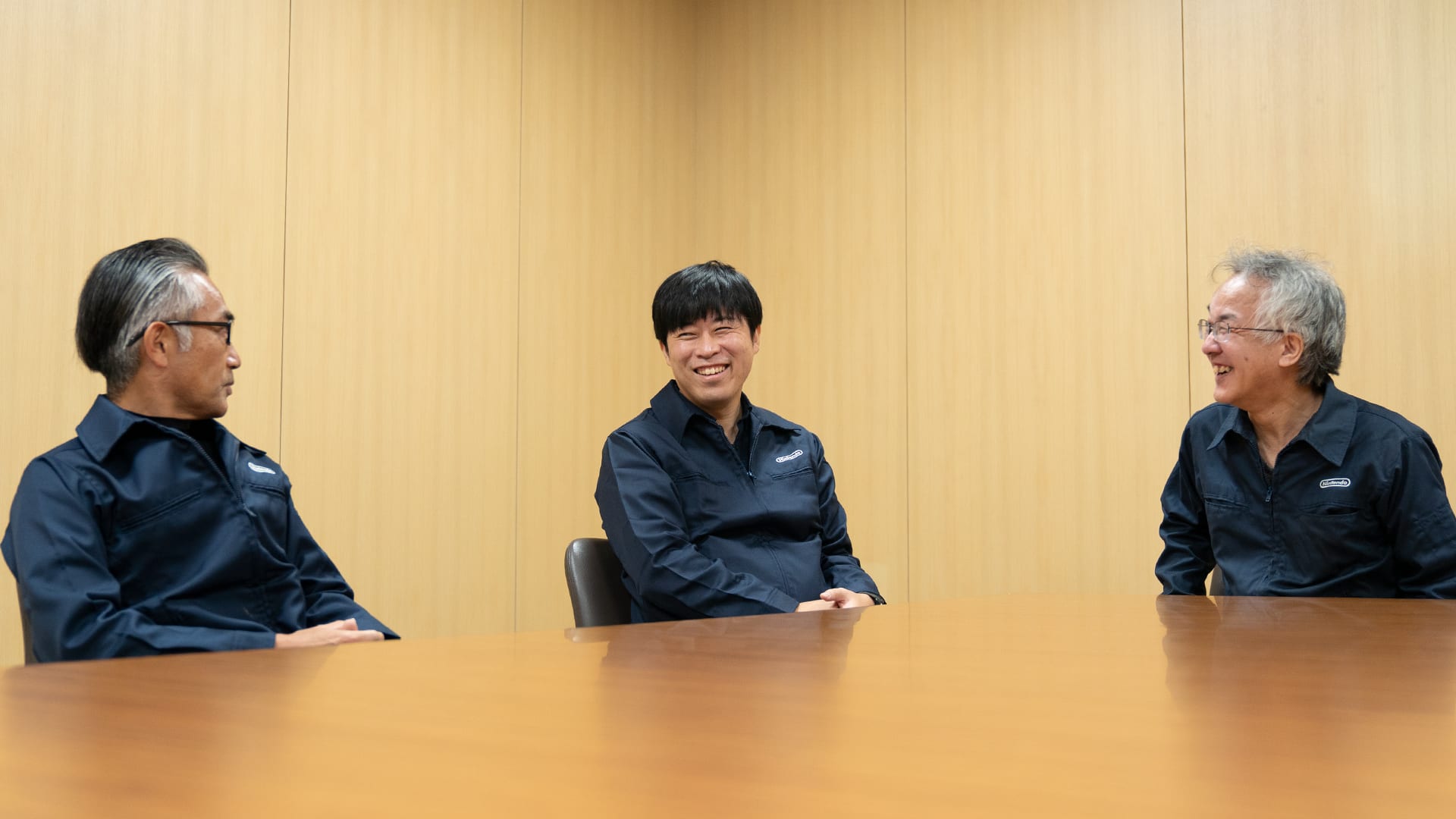
And now, I think Big Brain Academy: Brain vs. Brain is the kind of game that many adults can enjoy. How does this game appeal to adults?
Kubo:
While we've described how this game is something both parents and children can enjoy together, we didn't forget to create something adults can enjoy as well. I mentioned the monitor testing with younger children, but we also conducted adult monitor testing with the debug team(8) for research into the game's replayability. This testing targeted those who play games on a regular basis.
(8)A quality-assurance team that plays in-development games and investigates issues with programs.
Yoshinobu:
By any chance were there testers there who had been involved in the Nintendo DS or Wii versions and were therefore skilled Big Brain Academy experts?
Kubo:
Yes, there were. Some of the monitor testers ranked at the "King"(9) level in the Nintendo DS version. (Laughs)
(9) The highest grade a player could be given based on the test results from the Nintendo DS version of Big Brain Academy. (The Wii version used a rank of A++.) The Nintendo DS game's grades ranged from F- (the lowest) to King (the highest). The Wii game's grades ranged from Novice (the lowest) to A++ (the highest).
Fujii:
That's amazing. The Nintendo DS version came out 16 years ago (10). That's such a long-term career... (Laughs)
(10) Big Brain Academy released in Japan in June 2005.
Kubo:
But they couldn't play like they used to, so they were like, “Wait – is my brain getting less flexible?”. (Laughs)
(Laughs)
Kubo:
Aiming for higher scores in Big Brain Academy is another exciting feature of the game. I mentioned earlier that we analysed the mechanics of the Practice mode in terms of how the game chooses which quizzes to give players. Because of that analysis, we had a clearer vision of the structure of the game. For instance, we knew how high of a score a player could obtain based on their speed and when they avoided incorrect answers. And I thought that it might actually make it easier for a player to aim for a higher score if that was shown to them.
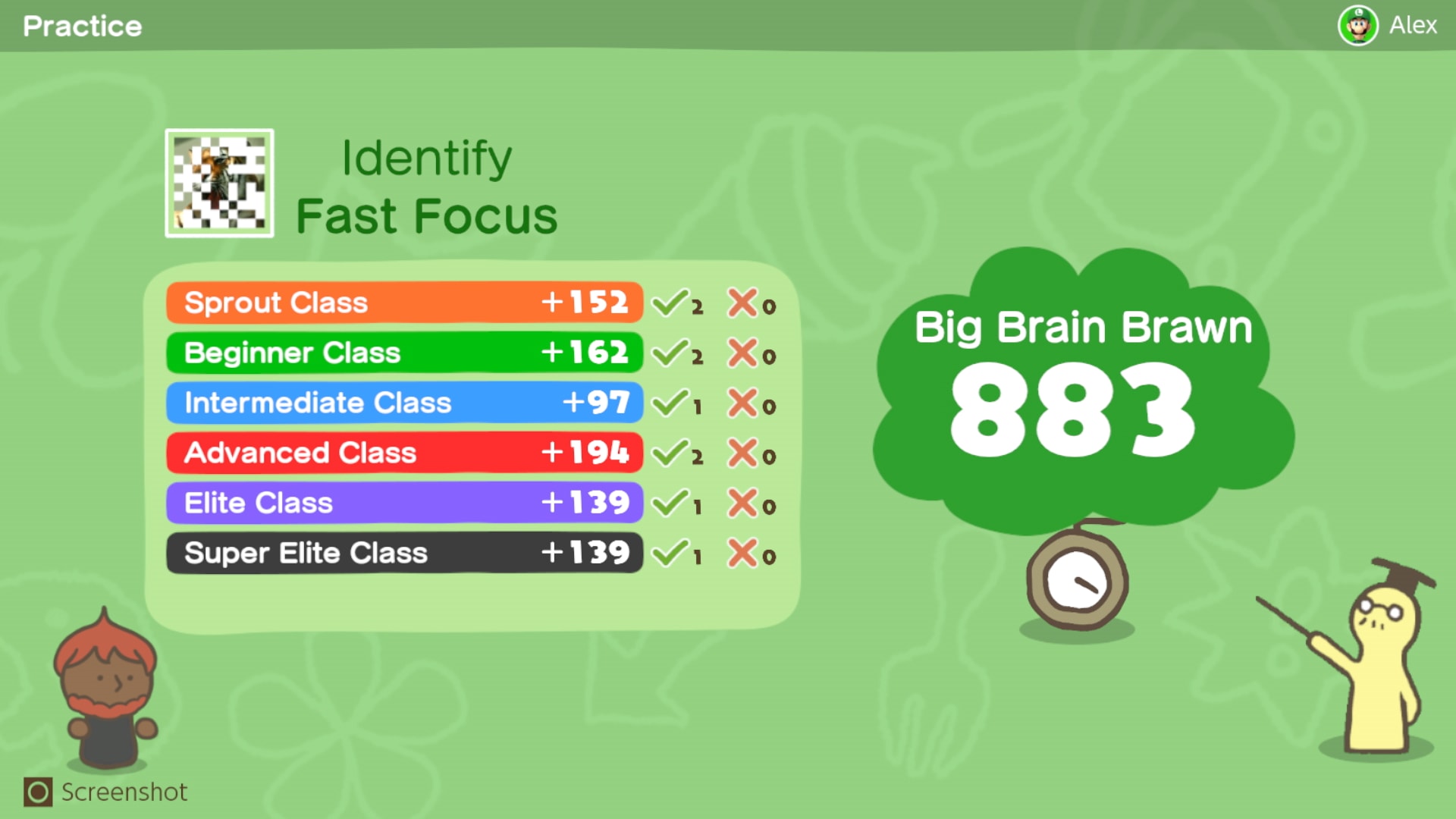
Yoshinobu:
It's true that it's fun and motivating seeing the class level the quiz belongs to while you're solving it.
Kubo:
I think this game will also be challenging for adults who keep track of how much they've played or how many correct answers they've got. For example, they might know they're about to level up to Advanced Class, or they might realise that if they just solve two or so more quizzes, they may even achieve Elite Class.
Fujii:
So it's important that even if players lose, they remain optimistic and motivated. The goal is to have them think, "I can win next time if I just try again!".
Kubo:
Although it looks simple on the surface, there's a complicated program running in the back end that increases or decreases the class and score based on the player's answers. I came up with a way for that to not come across to players but still have them enjoy getting points.
So on the outside it all looks easy, but behind the scenes there's the complicated task of maintaining game balance. By the way, how did you choose which minigames would be shown?
Kubo:
As this game was planned to be released globally, one of the things we considered was selecting minigames that players from all over the world could play and enjoy. Furthermore, in order to make it a game that anyone could enjoy, I put a lot of thought into things like selecting games with easily understood rules and lining up the games on the screen in such a way that they start with the easier ones.
It really is wonderful that anyone can enjoy it without prior knowledge or experience.
Chapter 3: Serious vs. serious: compete without holding back
Big Brain Academy: Brain vs. Brain features a new mode called "Ghost Clash". Can you please tell us about it?
Kubo:
Yes. Your “Ghost” is your play data generated from playing Practice and Test in the main mode. All of your in-quiz behaviours, such as the timing of selecting answers, which answers you selected, the movement of the cursor, and so on are recorded as the Ghost data and uploaded to the internet server.
I see. The Mario Kart series(11) has used the same mechanic. It has players compete against “ghosts,” which are the records from other players.
Kubo:
Yes. Using online features(12), this title allows you to battle Ghosts from around the world in the Practice mode's minigames.
(11)An action-racing game series in which players compete for ranks and time by racing karts on various circuits with Mario and other characters in the driver's seat. Since the first title was released in 1992 on Super Famicom(13), the series' titles have been released on consoles such as Nintendo 64, Nintendo DS, and Wii.
(12)Nintendo Switch Online membership (sold separately) and Nintendo Account required for online play. Not available in all countries. Internet access required for online features. Terms and conditions apply. For more information, please visit nintendo.com.au/switch-online. A Nintendo Switch Online membership is not required to play Ghost Clash against other users on the same console.
(13) The Super Famicom was released in Europe in 1992 under the name Super Nintendo Entertainment System.
When I hear about online battles, it makes me think of competing against someone in real time. But in this case, players are competing against someone’s Ghost instead. What was the reason behind this decision?
Kubo:
We wanted a wide range of consumers to play as much as possible, so we wanted to make something casual instead of a competitive real-time match.
Fujii:
Since it's a Ghost match and you're not competing directly against someone in real time, I like that you don't have to feel as much pressure. This game of brain-bending activities makes you feel like it's a competition, and sometimes things can heat up and leave even adult players feeling frustrated when they lose. But when you compete against Ghost data, you can play without hesitation and whenever it's convenient for you. You can play in secret and never reveal your results to your opponent. I thought I could even call it an "invention."
Kubo:
Thank you. When you play against Ghosts from around the world, it shows your results, but your opponent doesn't get notified. This way, I think players can challenge others without feeling self-conscious.
Real-time online matches are a bit nerve-racking, aren't they? You can't even go to the bathroom during overly long matches. (Laughs)
Kubo:
Yeah...I understand. No one wants to lose. (Laughs)
Yoshinobu:
The Wii version also had Ghost-style matches, but they were limited to Ghosts of your friends who you had exchanged friend IDs with. But now you can play with Ghosts from around the world online on Nintendo Switch.
Kubo:
Yes. Unlike real-time matches, you don't need to wait for the other players to turn up, since the Ghost data from around the world is already waiting for you. This means that you can be matched straight away with players at just the right level for you. And you can even do Ghost battles against family members on the same console without using online features.
I see. So you'll be able to play against someone anytime, whenever you feel like it.
Fujii:
Talking about Ghost battle has reminded me of a story from the time of the Wii version. One day when I got home, my child was waiting in the hallway to excitedly tell me about beating my Ghost. To which I responded, "We'll see about that...".
Kubo:
Aha, so then a battle started in your living room.
Fujii:
Yes, exactly. (Laughs)
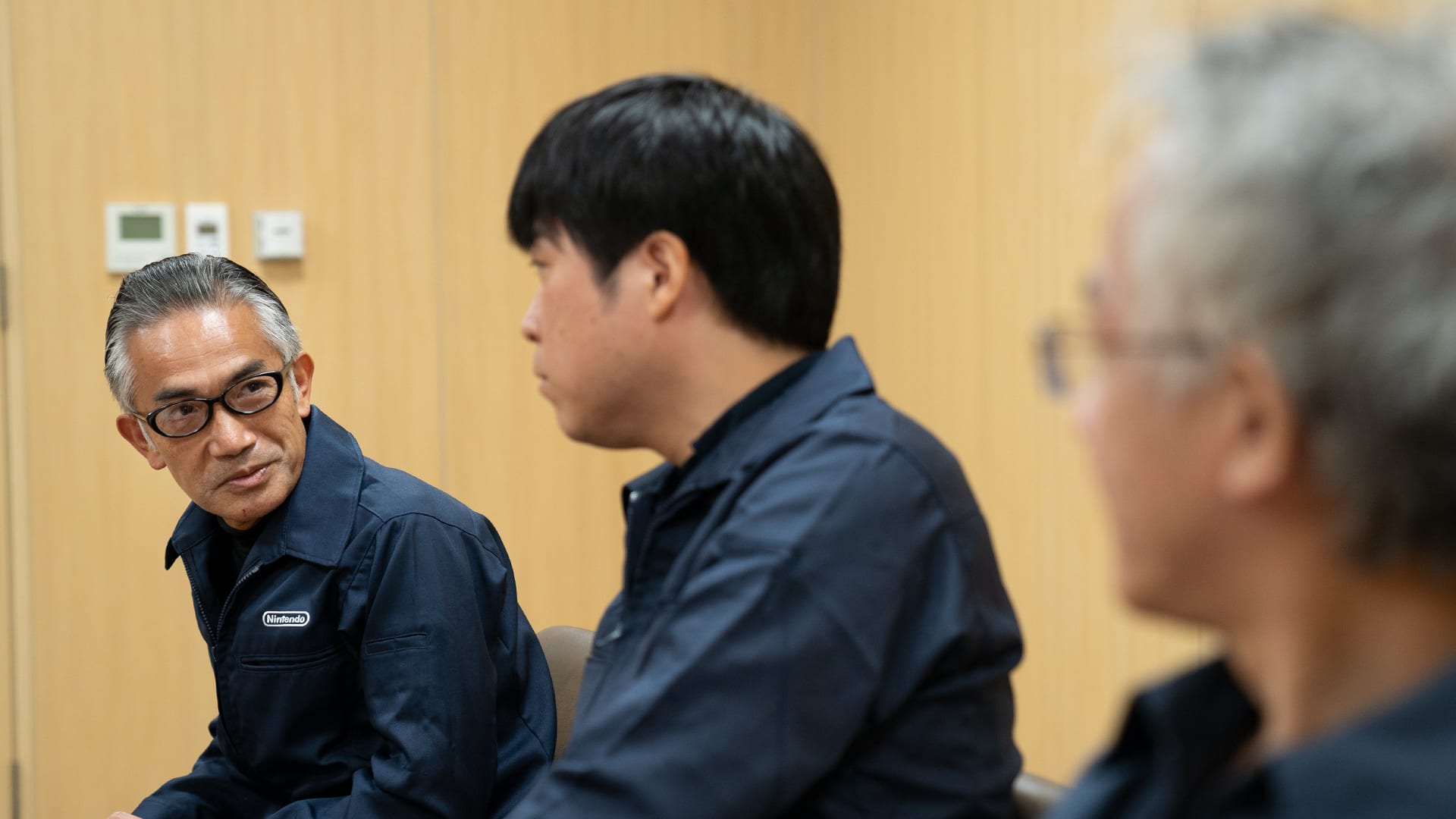
It's nice that you can do Ghost battles with your child even when you're busy with work. You can battle with friends and family without setting a time.
Kubo:
Also, for the Ghosts in this game, we worked hard to make sure you feel like you're playing against a real person. We wanted to give you the sense that you're actually playing with someone, even though it's just their play data.
And how did you manage that?
Kubo:
For this game, we made it so that you can customise your own avatar. For example, when someone is answering a question during a quiz show, the face of the person answering appears on-screen so you can tell who it is.
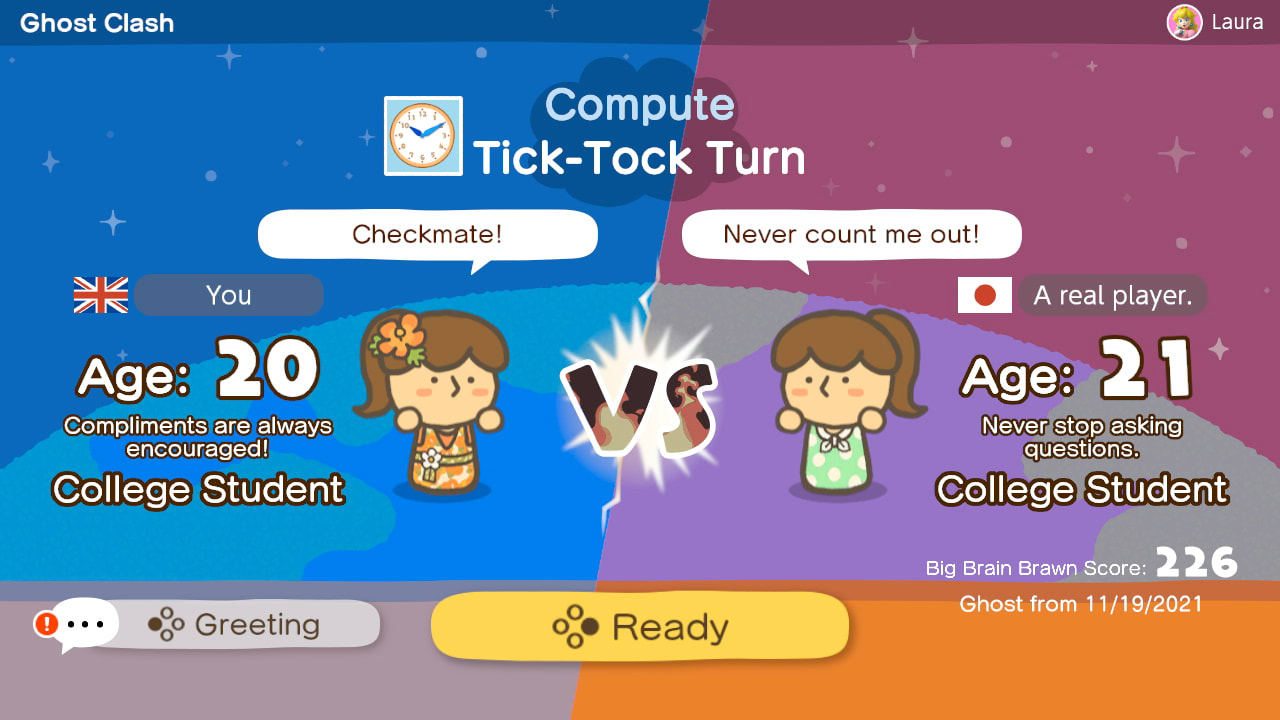
That's true. Even if it's just a Ghost, if you can see a face, then it feels like you're actually playing against someone.
Kubo:
Also, we made it so that you can set an age for the avatar. This is a battle of brain-bending activities, so we wanted to make the opponents' ages clear – for example, whether it's child vs. adult or adult vs. adult. Of course, it's also possible to make your age a secret. Additionally, you can select things to add individuality to your avatar, like a catchphrase, occupation, or outfit.
Occupation?
Kubo:
Yes, occupation. For example, players can choose things like Preschooler, College Student, Office Worker, or Manager.
Fujii:
Office Worker vs. Manager... That combination must also be fun. (Laughs)
In the main Practice mode, as you play through the game, you'll unlock more items for your avatar, such as clothing and hats. You can enjoy seeing how other players have decided to dress up their avatars.
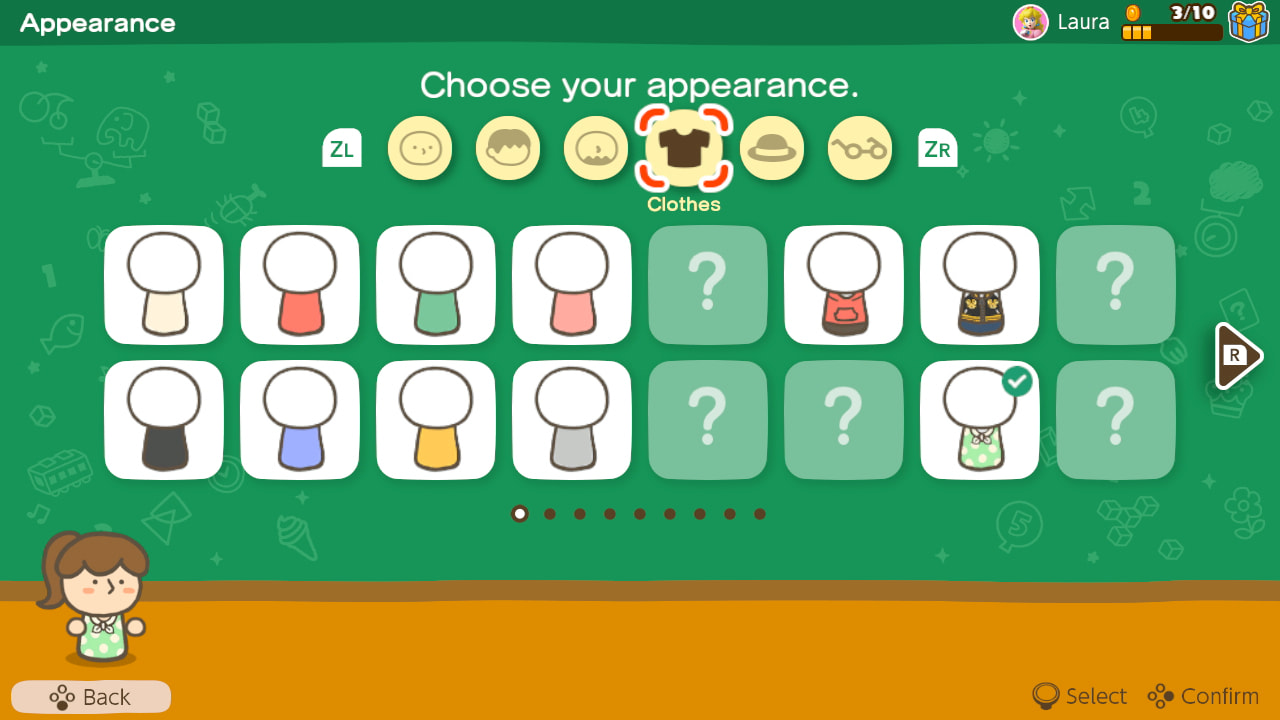
Among the development team, we played Ghost Clash battles with lots of different people, and there were some people with rather eccentric tastes in clothing... (Laughs)
It's fun seeing how the personality of an individual shines through.
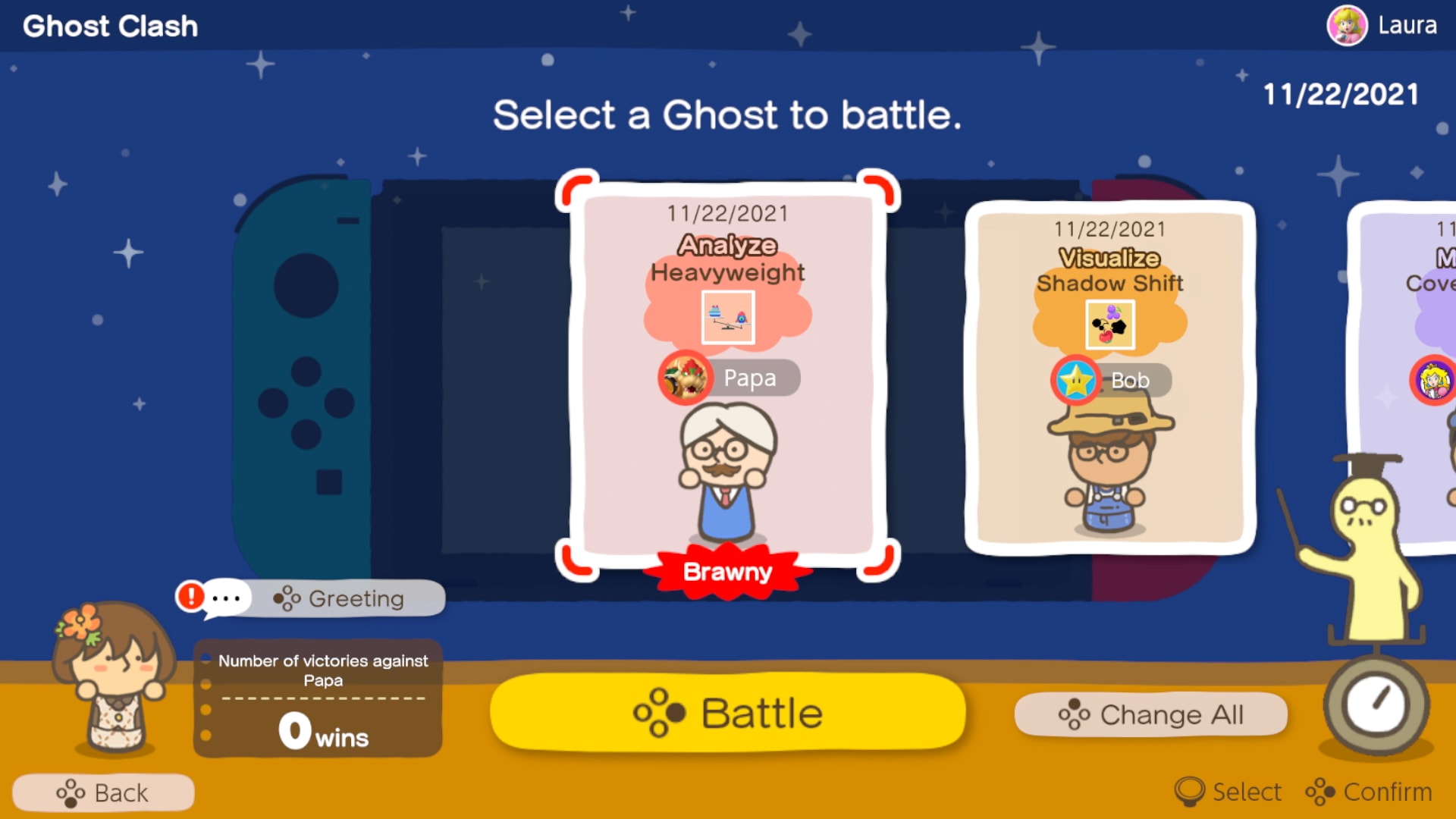
Are there any other features unique to this game?
Kubo:
The Party mode is a key feature for the Nintendo Switch version. In addition to being able to sit with others in front of a TV and play together, you can also put the Nintendo Switch flat on a table and play facing each other using touch controls. That's a newly added way to play together in this game.
Since we're all here, shall we give it a go? Come on, Fujii-san! Let's spin the wheel to decide on a minigame.
Fujii:
Oooh, Balloon Burst! This is a good one!
Yoshinobu:
Oh, I messed up!
Fujii:
Ah! Come on, come on!
Kubo:
It looks fun! (Laughs)
Fujii:
This is good. Playing facing each other with touch controls like this really makes it feel more immediate and personal.
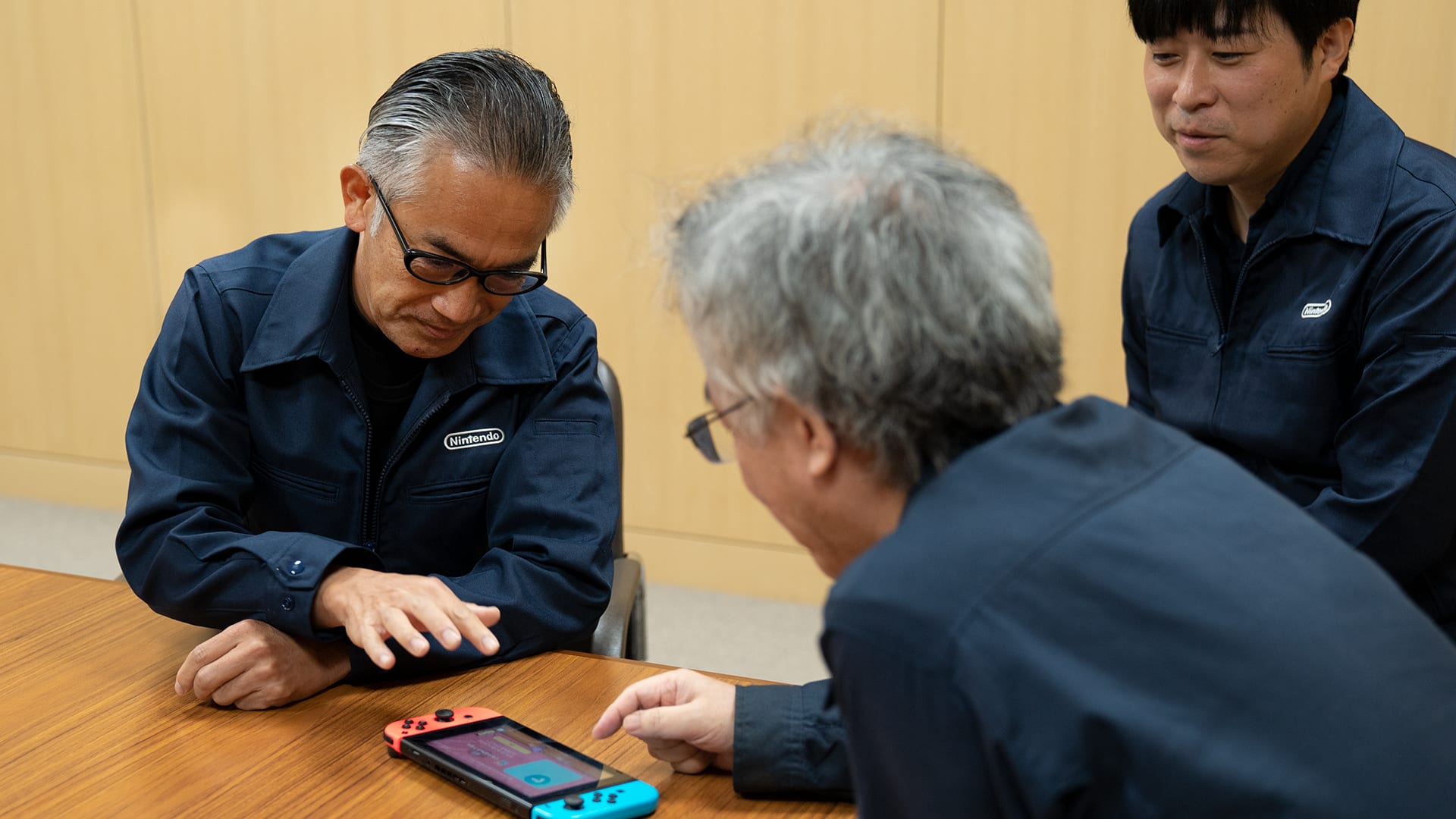
Yoshinobu:
When the official trailer for this game was released and I saw two people sitting facing each other using touch controls on a single Nintendo Switch console, I was extremely happy. It's exactly these touch controls that I felt were carrying on the legacy of this relationship between parent and child that we had originally imagined.
Kubo:
We also fine-tuned it so that it's fun to play with a controller too, so I hope players will try out both.
The game has a Party mode* that you play with multiple people. What would you say its strengths are as a party game?
*Additional accessories may be required for multiplayer mode. Sold separately.
Kubo:
You can start playing straight away, even without prior experience or knowing the rules. Also, each player can select their class, which means they can adjust the difficulty level for themselves. When playing against each other, each player can choose a difficulty from Sprout Class to Super Elite Class.
So, for example, a young child and a parent can play on equal terms by selecting Sprout Class and Advanced Class respectively. This means that even in combinations like child vs. parent or gamer vs. non-gamer, everyone can select the class that fits best for them, then play without holding back. It's often the case that when children and parents play against each other, the parents will hold back so they're on the same level – but children are actually surprisingly good at seeing through this. So by having different difficulty levels for children and parents, it allows both of them to try their hardest.
If it's not balanced, then the person who wins increases their class by one. And then both players can play seriously against each other. …Shall we try this too?
Fujii:
I haven't done it in a while, so I think it'll be Sprout Class for me…
Kubo:
Sprout Class? Then since I'm the director, I'll choose Elite Class.
Yoshinobu:
Ooh…
Fujii:
Ah, I'm a little rusty …
Kubo:
Oh no, I messed up! Aaah!
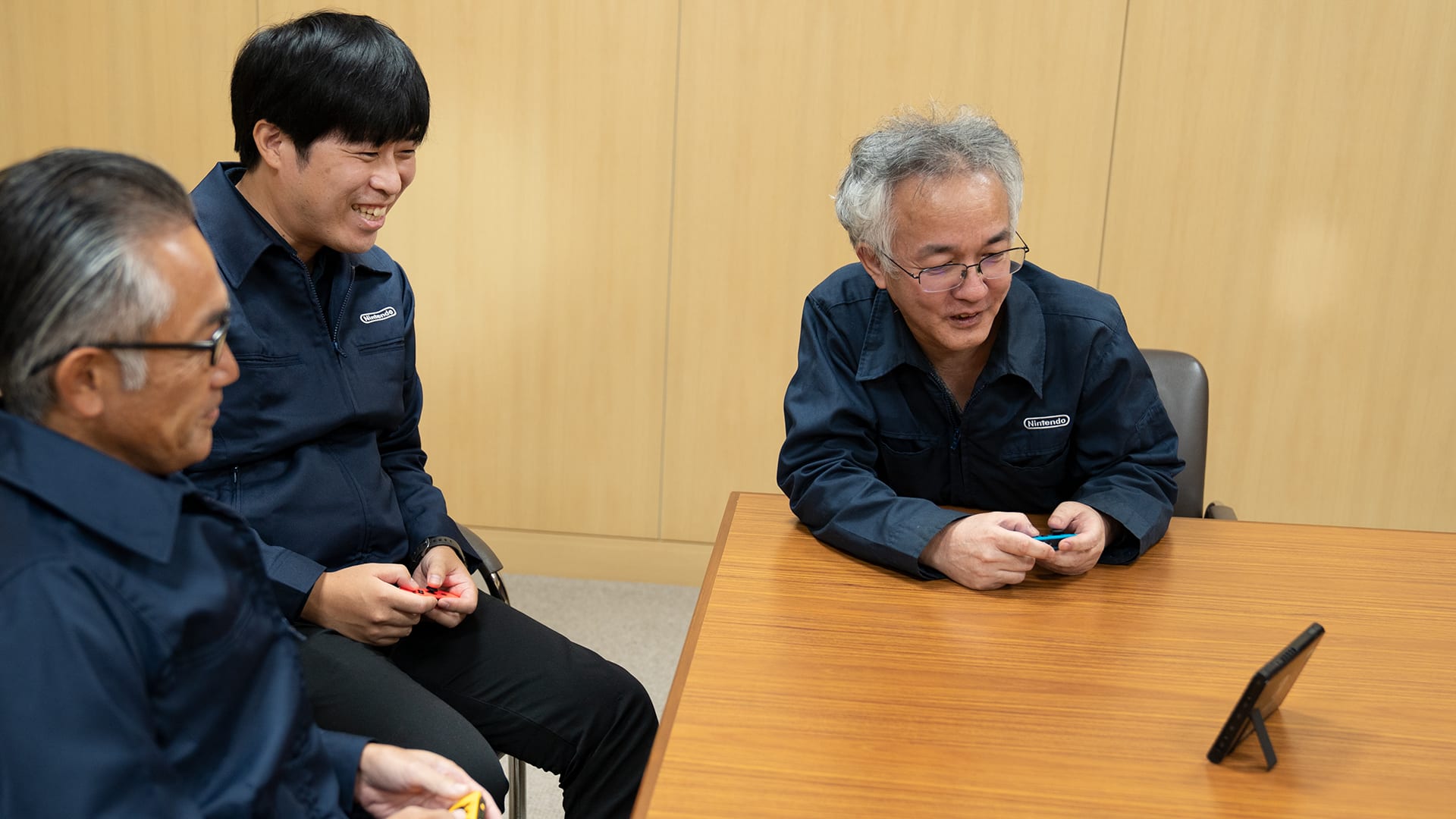
Yoshinobu:
It's great that you get so seriously into it that even as adults you start making sounds like those.
I can really see how much you're all enjoying it. (Laughs)
Kubo:
Along with the class changes, we've implemented other features. For instance, we made it so that the person who loses gets to choose the next minigame so they can pick an activity that they're good at.
Fujii:
I see. You're right. A fun aspect of Big Brain Academy is that everybody has strengths and weaknesses in different categories.
Kubo:
That's right. For example, a child might be better at Memorize than an adult, or there might be two people the same age, one good at Identify and the other at Analyze. So different people win with different categories.
Fujii:
Exactly. It's exciting to say things to each other like, "You really are the type of player who can intuitively identify things".
So by being able to choose the difficulty class and the category, you can really compete against each other seriously.
Kubo:
It's fun when both people can try to do their best instead of having to hold back. It's serious vs. serious. We want people to compete without holding back.
I'm sure there are fun times ahead as people meet up this holiday season, and there may be some unexpected defeats when they play against each other. (Laughs)
Everyone:
(Everyone laughs)
Kubo:
If you're confident in your skills, then I hope you try playing against someone else in the Elite or Super Elite classes. There will be lots of challenging tasks, so I believe you'll get really into it!
Now, to wrap up, I'd like to ask each of you to give a comment on how you want people to play the game.
Fujii:
This is a game that can be enjoyed by people of a wide range of ages, so I hope they will all enjoy it in their own ways. Friends can compete with each other in a battle of the brains, or families can play together, enjoying the feeling of solving things as parent and child and as a gateway to learning. I also hope it inspires conversations between grandparents and grandchildren.
Yoshinobu:
Of course I hope a wide range of players will enjoy the game, but I especially want players to use this game as a communication tool between parents and children. I'm hoping this game provides a starting point of opportunities for parents to be more engaged and involved in their children’s learning, even beyond the game. For instance, they can solve problems together while they're studying, and parents can support an environment for their children to be able to enjoy studying. This, I believe, will lead to everyone smiling.
Kubo:
For a household with younger children, I want them to play together. And for those who want a game that they can play casually and quickly, I think this one is a good option. For advanced players, the difficulty levels are precisely categorised, so I think they will find it rewarding to play.
Do you have anything to add for fans of the Nintendo DS and Wii versions of Big Brain Academy?
Kubo:
You can receive a medal for each activity based on your score, and for those that are familiar with the franchise, let me just say that we have, of course, a hidden, highest medal, which will be rather challenging to get. Furthermore, once you obtain all the medals, you unlock Super Practice, which is a challenging mode that gives you Advanced Class activities from the get-go. For those of you confident in your skills, please enjoy this feature as well!
Thank you very much for your time today.
Big Brain Academy: Brain vs. Brain launches December 3rd on Nintendo Switch. Find out more about this title at our Big Brain Academy: Brain vs. Brain gamepage.

